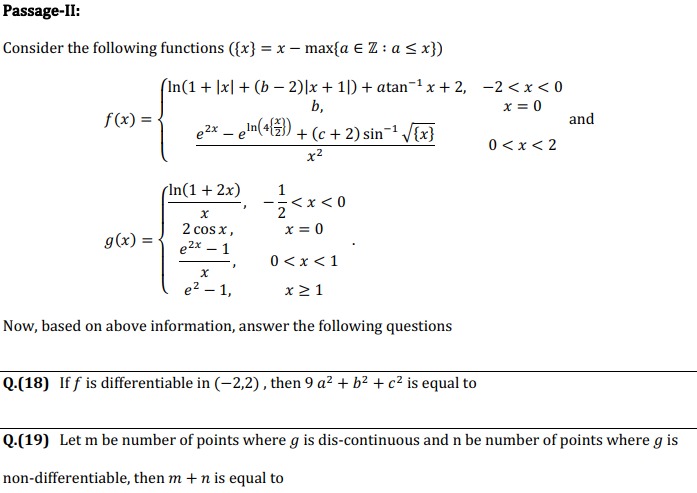Question
Question: Passage-II: Consider the following functions ({x} = x - max{a ∈ Z: a ≤ x}) $$ f(x) = \begin{cases} ...
Passage-II: Consider the following functions ({x} = x - max{a ∈ Z: a ≤ x})
f(x)=⎩⎨⎧ln(1+∣x∣+(b−2)∣x+1∣)+atan−1x+2,b,x2e2x−eln(42x)+(c+2)sin−1{x}−2<x<0x=00<x<2and g(x)=⎩⎨⎧xln(1+2x),2cosx,xe2x−1,e2−1x,−21<x<0x=00<x<1x≥1Now, based on above information, answer the following questions
Q.(19) Let m be number of points where g is dis-continuous and n be number of points where g is non-differentiable, then m + n is equal to

3
Solution
Let's analyze the function g(x) to determine the number of points where it is discontinuous (m) and non-differentiable (n).
Function g(x):
g(x)=⎩⎨⎧xln(1+2x),2cosx,xe2x−1,e2−1x,−21<x<0x=00<x<1x≥1Continuity Check:
We need to check continuity at the points where the definition of g(x) changes, which are x = 0 and x = 1.
-
At x = 0:
- Left-hand limit: limx→0−g(x)=limx→0−xln(1+2x). Using L'Hôpital's rule or the standard limit limu→0uln(1+u)=1, we have limx→0−xln(1+2x)=2.
- Function value at x = 0: g(0)=2cos(0)=2.
- Right-hand limit: limx→0+g(x)=limx→0+xe2x−1. Using L'Hôpital's rule or the standard limit limu→0ueu−1=1, we have limx→0+xe2x−1=2.
Since limx→0−g(x)=g(0)=limx→0+g(x)=2, g(x) is continuous at x = 0.
-
At x = 1:
- Left-hand limit: limx→1−g(x)=limx→1−xe2x−1=1e2−1=e2−1.
- Function value at x = 1: g(1)=e2−11.
- Right-hand limit: limx→1+g(x)=limx→1+e2−1x=e2−11.
Since limx→1−g(x)=e2−1 and limx→1+g(x)=g(1)=e2−11, and e2−1=e2−11, g(x) is discontinuous at x = 1.
Therefore, the number of points where g(x) is discontinuous is m = 1.
Differentiability Check:
-
At x = 0:
We need to check if the left and right derivatives at x = 0 are equal.
-
Left derivative: For x<0, g(x)=xln(1+2x). Using the quotient rule, g′(x)=x21+2x2⋅x−ln(1+2x)=x2(1+2x)2x−(1+2x)ln(1+2x). Then g′(0−)=limx→0−x2(1+2x)2x−(1+2x)ln(1+2x). Using Taylor series or L'Hôpital's rule (twice), we find g′(0−)=−2.
-
Right derivative: For x>0, g(x)=xe2x−1. Using the quotient rule, g′(x)=x22e2x⋅x−(e2x−1)=x22xe2x−e2x+1. Then g′(0+)=limx→0+x22xe2x−e2x+1. Using Taylor series or L'Hôpital's rule (twice), we find g′(0+)=2.
Since g′(0−)=−2 and g′(0+)=2, the left and right derivatives are not equal, so g(x) is not differentiable at x = 0.
-
-
At x = 1:
Since g(x) is discontinuous at x = 1, it is not differentiable at x = 1.
Therefore, the number of points where g(x) is non-differentiable is n = 2 (at x = 0 and x = 1).
Finally, m + n = 1 + 2 = 3.
Thus, m + n = 3.
